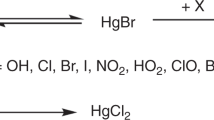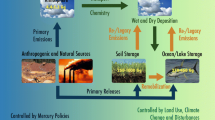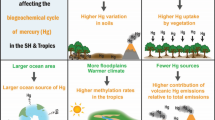Abstract
We use the global mercury model published by Bergan et al. (1999) to evaluate the potential role of ozone and the hydroxyl radical as gas phase oxidants for the oxidation of elemental mercury in the atmosphere. The magnitude of natural and man-made mercury emissions are taken from recent literature estimates. We consider only two mercury reservoirs, elemental mercury, Hg0, and the more soluble divalent form, HgII. Wet and dry deposition of HgII is explicitly treated.Applying monthly mean fields of ozone for the oxidation of gas phase Hg0 and using the reaction rate by Hall (1995) yields a global transformation of Hg0 to HgII which is too slow to keep the simulated concentration of Hg0 near observed values. This shows that there must be additional important removal processes for Hg0 or that the reaction rate proposed by Hall (1995) is too slow. A simulation in which the oxidation rate was artificially increased, so that the global turn-over time of Hg0 is one year and the simulated average concentration of Hg0 realistic, produces latitudinal and seasonal variations in Hg0 that do not support the hypothesis that gas phase reaction with O3 is the major oxidation process for Hg0.Recent studies indicate that OH may be an important gas phase oxidant for Hg0 (Sommar et al., 2001). Using OH as the sole oxidantand applying the oxidation rate by Sommar et al., we calculate aconcentration of Hg0 well below (about a factor of three) the observations. By prescribing a slower rate, corresponding to a turn-over time of Hg0 of one year, we calculate concentrations of both Hg0 in surface air and HgII in precipitation which correspond reasonably well, both in magnitude and temporal variation, with seasonal observations in Europe and North America. This result supports the suggestion that the oxidation by OH is an important pathway for the removal of Hg0. In view of the uncertainties associated with our calculations, this conclusion should still be regarded as tentative.
Similar content being viewed by others
References
Ames, M., Gullu, G., and Olmez, I., 1998: Atmospheric mercury in the vapour phase and fine and coarse particulate matter at Peach River, New York, Atmos. Environ. 32, 865–872.
Axenfeldt, F., Münch, J., and Pacyna, J., 1991: Europäische Test-emissionsdatenbasis von Quecksilberkomponenten für Modellrechnungen, Umweltforchungsplan des Bundesministers für Umwelt, Naturschutz und Reaktorsicherheit-Luftreinhaltung-104 02 726.
Benoit, J. M., Fitzgerald W. F., and Damman, A. W., 1994: Historical atmospheric mercury deposition in the midcontinental U.S. as recorded in an ombotrophic peat bog, in C. Watras and J. Huckabee (eds), Mercury Pollution: Integration and Synthesis, Lewis Publishers, Boca Raton, Florida, Chapter II.2.
Bergan, T., Gallardo, L., and Rodhe, H., 1999: Mercury in the global atmosphere; A three dimensional model study, Atmos. Environ. 33, 1575–1585.
Bullock, R. Jr., Benjey, W. G., and Keating, M. H., 1997: The modeling of regional scale atmospheric mercury transport and deposition using RELMAP, in J. E. Baker (ed.), Atmospheric Deposition of Contaminants to the Great Lakes and Coastal Waters, SETAC, Pensacola, FL, pp. 323–347.
Burke, J., Hoyer, M., Keeler, G., and Scherbatskoy, T., 1995: Wet deposition of mercury and ambient mercury concentrations at a site in the Lake Champlain basin, Water Air Soil Pollut. 80, 353–362.
Carpi, A. and Lindberg, S., 1997: Application of a teflon™ dynamic flux chamber for quantifying soil mercury flux: tests and results over background soil, Atmos. Environ. 32, 873–882.
Crutzen, P. J. and Zimmermann, P. H., 1991: The changing photochemistry of the troposphere, Tellus 43AB, 136–151.
Ebinghaus, R., Tripathi, R. M., Wallschläger, D., and Lindberg, S. E., 1999: Natural and anthropogenic mercury sources and their impact on the air-surface exchange of mercury on regional and global scales, in R. Ebinghaus et al. (ed.), Mercury Contamined Sites, Springer Verlag, New York, pp. 1–50.
Ebinghaus, R. and Schmolke, S. R., 2000: Spatial and temporal variability of atmospheric mercury concentrations in north-western and central Europe, Proceedings of the NIMD Forum 1999, National Institute for Minamata Disease, Minamata, Japan, in press.
Feichter, J. and Crutzen, P., 1990: Parameterization of vertical tracer transport due to cumulus convection in a global transport model and evaluation with 222Radon measurements, Tellus 42B, 100–117.
Ferrera, R., Mazzolai, B., Lanzilotta, E., Nucaro, E., and Pirrone, N., 1999: Abstract from the 5th International Conference on Mercury as a Global Pollutant, 23–28 May 1999, Rio de Janeiro, p. 122.
Fitzgerald, W. F., 1989: Atmospheric and oceanic cycling of mercury, in J. P. Riley and R. Chester (eds), Chemical Oceanography Series, Chapter 57, Vol. 10, Academic Press, pp. 151–186.
Fitzgerald, W. F., Mason, R. P., Vandal, G. M., and Dulac, F., 1994: Air-water cycling of mercury in lakes, in C. Watras and J. Huckabee (eds), Mercury Pollution: Integration and Synthesis, Lewis Publishers, Chelsea, pp. 203–220.
Gallardo, L. and Rodhe, H., 1995: Evaluation of a global 3-D model of tropospheric oxidized nitrogen, Report CM-85, International Meteorological Institute in Stockholm, Department of Meteorology, Stockholm University.
Galperin, M., Sofiev, M., and Mantseva, E., 1996: A model of the geochemical transformation of mercury and its long-range atmospheric transport, in W. Baeyens et al. (eds), Global and Regional Mercury Cycles: Sources, Fluxes and Mass Balances, NATO ASI Series, 2, Environment, Vol. 21, Kluwer Academic Publishers, Dordrecht, pp. 219–227.
Gårdfeldt, K., Feng, X., Sommar, S., and Lindqvist, O., 2001: Total gaseous mercury exchange between air and water at river and sea surfaces in Swedish coastal regions, Atmos. Environ., accepted.
Gill, G. A., Guentzel, J. L., Landing, W. M., and Pollman, C. D., 1995: Total gaseous mercury measurements in Florida: The FAMS Project (1992–1994), Water Air Soil Pollut. 80, 235–244.
Glass, G. E., Sorensen, J. A., Schmidt, K. W., Rapp, G. R., Yap, D., and Fraser, D., 1991: Mercury deposition and sources for upper Great Lakes region, Water Air Soil Pollut. 56, 235–250.
Guentzel, J. L., Landing, W. M., Gill, G. A., and Pollman, C. D., 1995: Atmospheric deposition of mercury in Florida: The FAMS Project (1992–1994), Water Air Soil Pollut. 80, 393–402.
Gustin, M. S., Taylor, G. E., Leonard, T. L., and Keisler, R. E., 1996: Atmospheric mercury concentrations associated with geologically and anthropogenically enriched sites in central western Nevada, Environ. Sci. Technol. 30, 2572–2579.
Gustin, M. S. and Lindberg, S. E., 1999: Assessing the contribution of natural sources to regional atmospheric mercury budgets, Abstract from the 5th International Conference on Mercury as a Global Pollutant, 23–28 May 1999, Rio de Janeiro, p. 138.
Hall, B., 1995: The gas-phase oxidation of elemental mercury by ozone, Water Air Soil Pollut. 80, 301–315.
Hoyer, M., Burke, J., and Keeler, G., 1995: Atmospheric sources, transport and deposition of mercury in Michigan: Two years of event precipitation, Water Air Soil Pollut. 80, 199–208.
Iverfeldt, Å. and Lindqvist, O., 1986: Atmospheric oxidation of elemental mercury in the aqueous phase, Atmos. Environ. 20, 1567–1573.
Iverfeldt, Å., 1991a: Occurrence, turnover of atmospheric mercury over the Nordic countries, Water Air Soil Pollut. 56, 251–265.
Iverfeldt, Å., 1991b: Mercury in a forest canopy throughfall water and its relation to atmospheric deposition, Water Air Soil Pollut. 56, 553–564.
Iverfeldt, Å., Munthe, J., Brosset, C., and Pacyna, J., 1995: Long term changes in concentration and deposition of atmospheric mercury over Scandinavia, Water Air Soil Pollut. 80, 227–233.
Iverfeldt, Å., Munthe, J., and Hultberg, H., 1996: Terrestrial mercury and methylmercury budgets for Scandinavia, in W. Baeyens et al. (eds), Global and Regional Mercury Cycles: Sources, Fluxes and Mass Balances, NATO ASI Series, 2, Environment, Vol. 21, Kluwer Academic Publishers, Dordrecht, pp. 381–401.
Jonasson, I. R. and Boyle, R.W., 1971: Geochemistry of mercury, in Proceedings of Special Symposium on Mercury inMan's Environment, 15–16 February 1971, Royal Society of Canada, Ottawa, Ontario.
Kellerhals, M., Beauchamp, S., Belzer, W., Blanchard, P., Froude, F., Harvey, B., McDonald, K., Pilote, M., Poissant, L., Puckett, K., Schroeder, B., Steffen, A., and Tordon, R., 2000: Temporal and Spatial Variability of Total Gaseous Mercury in Canada: Results from the Canadian Atmospheric Mercury Network (CAMNet), Paper presented at Heavy Metal Conference in Ann Arbor.
Kim, J. P. and Fitzgerald, W. F., 1986: Sea air partitioning of mercury in the equatorial Pacific Ocean, Science 231, 1131–1133.
Kim, K-H., Lindberg, S. E., and Meyers, T. P., 1995: Micrometeorological measurements of mercury vapor fluxes over background forest soils in eastern Tennessee, Atmos. Environ. 29, 267–282.
Kim, K. H. and Kim, M. Y., 1999: The exchange of gaseous mercury across soil-air interface in a residential area of Seoul, Korea. Atmos. Environ. 33, 3153–3165.
Lacerda, L. D. and Marins, R. V., 1997: Antropogenic mercury emissions to the atmosphere in Brazil: The impact of gold mining, J. Geochem. Explor. 58, 2230–229.
Lamborg, C. H., Rolfus, K. R., Fitzgerald, W. F., Kim, G., and Mason, R. P., 1999: The atmospheric cycling and air sea exchange of mercury species in the south and equatorial Atlantic Ocean, Abstract from the 5th International Conference on Mercury as a Global Pollutant, 23–28 May 1999, Rio de Janeiro, p. 333.
Langner, J. and Rodhe, H., 1991: A global three-dimensional model of the tropospheric sulfur cycle, J. Atmos. Chem. 13, 225–263.
Leermakers, M., Baeyens, W., Ebinghaus, R., Kuballa, J., and Kock, H., 1997: Determination of atmospheric mercury during the North Sea experiment, Water Air Soil Pollut. 97, 257–263.
Lin, C-J. and Pehkonen S. O., 1997: Aqueous-free radical chemistry of mercury in the presence of iron oxides and ambient aerosols, Atmos. Environ. 31, 4125–4137.
Lin, C-J. and Pehkonen, S. O., 1999: The chemistry of atmospheric mercury: A review, Atmos. Environ. 33, 2067–2079.
Lindberg, S. E., Turner, R. R., Meyers, T. P., Taylor, G. E., and Schroeder, W. H., 1991: Atmospheric concentration and deposition of Hg to a deciduous forest atWalker BranchWatershed, Tennessee, U.S.A., Water Air Soil Pollut. 56, 577–594.
Lindberg, S. E., Meyers, T. P., Taylor, G. E., Turner, R. R., and Schroeder, W. H., 1992: Atmosphere-surface exchange of mercury in a forest: results of modeling and gradient approaches, J. Geophys. Res. 97, 2519–2528.
Lindberg, S. E., Hanson, P. J., Meyers, T. P., and Kim, K-H., 1998: Air/surface exchange of mercury vapor over forests-the need for a reassessment of continental biogenic emissions, Atmos. Environ. 32, 895–908.
Lindberg, S. E. and Meyers, T. P., 1999: Natural mercury sources: Gaseous emissions from subtropical wetlands in the Florida Everglades, Abstract from the 5th International Conference on Mercury as a Global Pollutant, 23–28 May 1999, Rio de Janeiro, p. 142.
Lindqvist, O., Johansson, K., Aastrup, M., Andersson, A., Bringmark, L., Hovsenius, G., Håkanson, L., Iverfeldt, Å., Meili, M., and Timm, B., 1991: Water Air Soil Pollut. 55, 1–261.
Lockhart, W. L., Wilkinson, P., Billeck, B. N., Hunt, R. V., Wagemann, R., Brunskill, G. J., 1995: Current and historical input of mercury to high latitude lakes in Canada and Hudson Bay, Water Air Soil Pollut. 80, 603–610.
Martínez-Cortizas, A., Pontevedra-Pombal, X., García-Rodeja, E., Nóvoa-Muñoz, J. C., and Shotyk, W., 1999: Mercury in a Spanish peat bog: Archive of climate change and atmospheric metal deposition, Science 284, 939–942.
Mason, R. P., Fitzgerald, W. F., and Morel, F. M. M., 1994a: The biogeochemical cycling of elemental mercury: Anthropogenic influences, Geochim. Cosmochim. Acta 58, 3191–3198.
Mason, R. P., O'Donell, J., and Fitzgerald, W. F., 1994b: Elemental mercury cycling within the mixed layer of the equatorial Pacific Ocean, in C. J. Watras and J. W. Huckabee (eds), Mercury Pollution: Integration and Synthesis, Lewis Publishers, Chelsea, pp. 83–98.
Munthe, J., Xiao, Z. F., and Lindqvist, O., 1991: The aqueous reduction of divalent mercury by sulfite, Water Air Soil Pollut. 56, 621–630.
Munthe, J., 1992: The aqueous oxidation of elemental mercury by ozone, Atmos. Environ. Part A, 26, 1461–1468.
Nriagu, J.O.and Pacyna, J.M.1988. Quantitative assessment of world wide contamination of air water and soil by tracemetalsNature,134–139
Pacyna, J. M., 1998: Heavy Metals, Chapter 7 of the AMAP Assessment Report: Arctic Pollution Issues. The Arctic Monitoring and Assessment Programme, PO Box 8100, N-0032 Oslo, Norway.
Pai, P., Karamchandani, P., and Signeur, C., 1997: Simulation of the regional atmospheric transport and the fate of mercury using a comprehensive Eulerian model, Atmos. Environ. 31, 2717–2732.
Pehkonen, S. O. and Lin, C-J., 1998: Aqueous photochemistry of divalent mercury with organic acids, J. Air Waste Manage. Assoc. 48, 144–150.
Petersen, G., Iverfeldt, Å., and Munthe, J., 1995: Atmospheric mercury species over Central and Northern Europe. Model calculation and comparison with observation from the Nordic air and precipitation network for 1987 and 1988, Atmos. Environ. 29, 47–67.
Pirrone, N., Keeler, G. J., and Nriagu, J. O., 1996: Regional differences in worldwide emissions of mercury to the atmosphere, Atmos. Environ. 30, 2981–2987.
Poissant, L. and Casimir, A., 1998: Water-air and soil-air exchange rate of total gaseous mercury measured at background sites, Atmos. Environ. 32, 883–893.
Poissant, L., 1999: Potential sources of atmospheric total gaseous mercury in the St. Lawrence River valley, Atmos. Environ. 31, 2537–2547.
Rotty, R. M., 1987: Estimates of seasonal variation in fossil fuel CO2 emissions, Tellus 39B, 184–202.
Ryaboshapko, A., Ilyin, I., Gusev, A., Afinogenova, O., Berg, T., Hjellbrekke, A. H., 1999: Monitoring and Modelling of Lead, Cadmium and Mercury Transboundary Transport in the Atmosphere of Europe, EMEP MSC-E report 1/99, msce@glasnet.nu mailto:msce@glasnet.nu
Schroeder, W. H., Munthe, J., and Lindqvist, O., 1989: Cycling of mercury between water, air and soil compartments of the environment, Water Air Soil Pollut. 48, 337–347.
Schroeder, W. H., Yarwood, G., and Niki, H., 1991: Transformation processes involving mercury Hg in the atmosphere-results from a literature survey, Water Air Soil Pollut. 56, 653–666.
Schroeder, W. H. and Munthe, J., 1998: Atmospheric mercury-an overview, Atmos. Environ. 32, 809–822.
Seigneur, C., Wrobel, J., and Constantinou, E., 1994: A chemical kinetic mechanism for atmospheric inorganic mercury, Environ. Sci. Technol. 28, 1589–1597.
Seigneur, C., Abeck, H., Chia, G., Reinhard, M., Bloom, N. S., Prestbo, E., Saxena, P., 1998: Mercury adsorption to elemental carbon (soot) particles and atmospheric particulate matter, Atmos. Environ. 32, 2649–2657.
Shannon, J. D. and Voldner, E. C., 1995: Modeling atmospheric concentrations of mercury and deposition to the Great Lakes, Atmos. Environ. 29, 1649–1661.
Shia, R. L., Seigneur, C., Pai, P., Ko, M., and Sze, N. D., 1999: Global simulation of atmospheric mercury concentrations and deposition fluxes, J. Geophys. Res.-Atmos. 104, 23747–23760.
Slemr, F., Schuster, G., and Seiler, W., 1985: Distribution, speciation and budget of atmospheric mercury, J. Atmos. Chem. 3, 407–434.
Slemr, F. and Langer, E., 1992: Increase in global atmospheric concentrations of mercury inferred from measurements over the Atlantic Ocean, Nature 355, 434–437.
Slemr, F., 1996: Trends in atmospheric mercury concentrations over the Atlantic ocean and the Wank Summit, and the resulting constraints on the budget of atmospheric mercury, in W. Baeyens, R. Ebinghaus, and O. Vasiliev (eds), Global Regional Cycles: Sources, Fluxes and Mass Balance, NATO-ASI-Series, Kluwer Academic Publishers, Dordrecht, The Netherlands, pp. 33–48.
Sommar, J., Gårdfeldt, K., Strömberg, D., and Feng, X., 2001: A kinetic study of the gas-phase reaction between the hydroxyl radical and atomic mercury, Atmos. Environ., submitted.
Vandal, G. M., Rolfhus, K. R., Lamborg, C. H., and Fitzgerald, W. F., 1999: Mercury cycling and emissions from Long Island Sound, U.S.A., Abstract from the 5th International Conference on Mercury as a Global Pollutant, 23–28 May 1999, Rio de Janeiro, p. 332.
Verta, M., Mannio, J., Iivonen, P., Hirvi, J-P., Järvinen, O., Pieppoonen, S., 1990: in Kauppi, P., Kenttämies, K., and Anttila, P. (eds), Acidification in Finland, Springer-Verlag, Heidelberg, p. 883–908.
Xiao, Z., Munthe, J., Schroeder, E. W., and Lindqvist, O., 1991: Vertical fluxes of volatile mercury over forests, soil and lake surfaces in Sweden, Tellus 43B, 267–279.
Zimmermann, P., 1984: Ein dreidimensionales numerisches transportmodell fur atmosphärische spurenstoffe, Dissertation, University of Mainz, F.R.G., p. 163.
Zimmermann, P., 1987: MOGUNTIA a handy global tracer model, XVI NATO/CCMS International Technical Meeting on Air Pollution Modeling and Application, Lindau, Lake Constance, FRG, 6–10 April.
Zimmermann, P., Feichter, L., Rath, H., Crutzen, P., and Weiss,W., 1989: A global three-dimensional source receptor model investigation using 85Kr, Atmos. Environ. 23, 25–35.
Author information
Authors and Affiliations
Rights and permissions
About this article
Cite this article
Bergan, T., Rodhe, H. Oxidation of Elemental Mercury in the Atmosphere; Constraints Imposed by Global Scale Modelling. Journal of Atmospheric Chemistry 40, 191–212 (2001). https://doi.org/10.1023/A:1011929927896
Issue Date:
DOI: https://doi.org/10.1023/A:1011929927896




